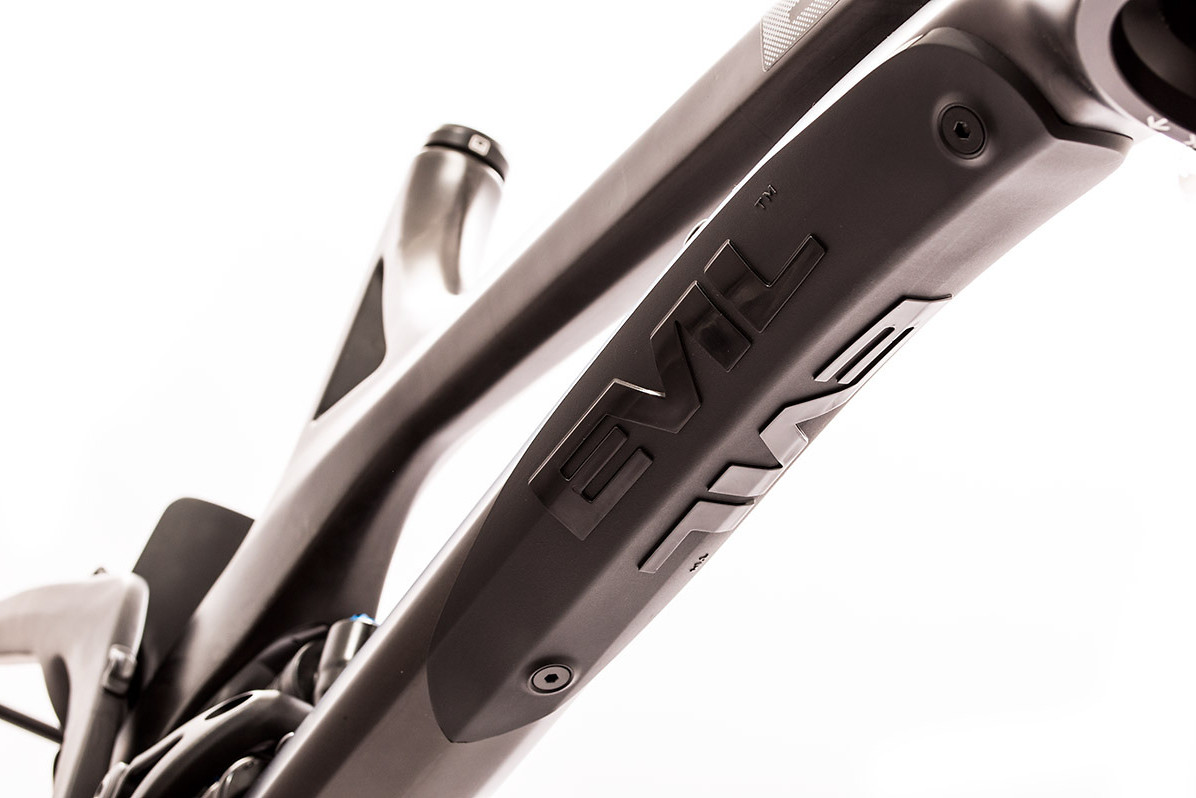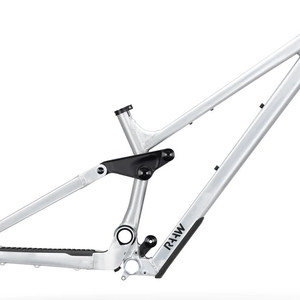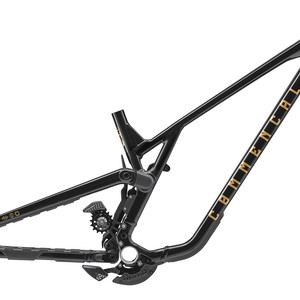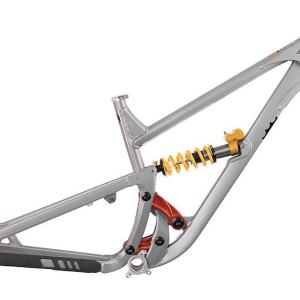Evil Undead Frame
(discontinued)
| Where To Buy | |||
|---|---|---|---|
Free shipping on orders over $50 (continental U.S. only).
International shipping available. Some exclusions apply. |
|||
Free shipping on orders over $50 (continental U.S. only).
International shipping available. Some exclusions apply. |
|||
Reviewed by Fred Robinson // Photos by Ian Collins // Studio shots by Fanatik Bike Co.
After riding squishy bikes made out of aluminum down bumpy hills for several years, I had no real desire to try any other frame material for my downhill bike. I was happy with aluminum - no real complaints from me. That was until the day I saw a photo of a matte-black plastic Batmobile on two wheels and instantly thought to myself "I need that in my life, right now." There was nothing wrong with my current bike, it had modern geometry, bad ass suspension, and could ride faster than I ever could, but I just wanted to try something new all of a sudden, simply because the plastic bike looked so damn sexy. So I pulled the trigger on the Evil Undead. This review is coming from your typical, semi-slow... I mean Cat 1 level rider. I don't ride for anyone, I look up to dudes like Sam Hill and Steve Peat, and I like riding my bike down bumpy hills as fast as I possibly can.

Since I wasn't ready to drop the duckets for a complete new build, I ended up doing a complete parts swap from my other bike - same fork, same bars, same wheels - same everything except what for Evil supplies with the frame, including some trick integrated goodies like an adjustable headset, a chainstay guard, fork-bumpers that double as cable-guides and a slick integrated fender. As much as I'd like all new parts, swapping components has its advantages. I'm already used to everything and can really hone-in on how the frame handles and its unique characteristics versus an all-new setup.
Undead Highlights
- High-pressure molded unidirectional carbon frame
- 203mm (8-inches) rear travel
- 9.5x3.0-inch FOX RC4 Kashima rear shock
- Adjustable bottom bracket height via flip-chip linkage
- Adjustable head angle via keyed-in Evil headset
- DELTA suspension system with high-load spherical Enduro bearing
- Integrated fork bumpers that double-duty as cable guides
- Integrated removable downtube protector and shuttle guard
- Integrated removable carbon rear fender
- Rubber chainstay guard
- Metal rotor, chain-ring, and chain-slap guards
- Tapered headtube
- 150mm x 12mm rear thru axle with replaceable rear dropouts
- 83mm bottom-bracket with replaceable ISCG-05 tabs
- Frame weight (size Medium with shock): 10.06-pounds (4.6kg)
- MSRP $3,350

The Undead utilizes Dave Weagle's DELTA System (Dave's Extra Legitimate Travel Apparatus). Similar to DW's other linkage designs, the frame has a nice balance of pedaling performance and neutral braking, but I personally feel it handles the rough slightly better than some dw-link bikes I've ridden in the past. While quite similar to the aluminum Evil Revolt in terms of geometry, sizing, and suspension design, the Undead uses Evil's original non-floating shock design and a lower center of mass due to a flipped shock orientation. Evil also upgraded the linkage to a double-shear arrangement with a high-load spherical bearing in place of the Revolt's composite bushing system.
The DELTA system was designed to provide three different stages throughout the bike's travel. First, a supple beginning stroke. Second, a mid-stroke leverage ratio intended to provide as much traction as possible. Finally, a lower leverage rate at the end that ramps up to create a bottomless feel and help prevent harsh bottom-outs. These stages are achieved by the system's dual progressive leverage curve (progressive, near linear, then progressive again).

One advantage of the DELTA system is the ability to change the geometry of the bike via the flip-chips and not affect the leverage rate or suspension feel, so you can change the geometry of your bike and not have to re-tune your shock to get it back to where you like it. You can also rotate the integrated headset for further adjustments. For my size Large frame, stock geometry options include the following:
Steep/High: BB 14.1-inches // Head Angle 64.5-degrees // Wheelbase 46.32-inches // Chainstay: 17.2-inches
Steep/Low: BB 13.83-inches // Head Angle 64.0-degrees // Wheelbase 46.42-inches // Chainstay: 17.2-inches
Slack/High: BB 13.9-inches // Head Angle 63.5-degrees // Wheelbase 46.92-inches // Chainstay: 17.2-inches
Slack/Low: BB 13.7-inches // Head Angle 62.9-degrees // Wheelbase 47.01-inches // Chainstay: 17.2-inches
My measured numbers vary slightly, but they're in the same ballpark:
Slack/Low: BB 13.6-inches // Head Angle 62.3-degrees // Wheelbase 47.0-inches // Chainstay: 17.2-inches
Unfortunately information is limited regarding the carbon construction techniques used on the Undead. What we do know is it is built using high-pressure molded unidirectional carbon, and that Evil spent a long time tracking down the best factory to build it. The use of unidirectional carbon allows Evil to fine tune different areas of the frame as far as stiffness and flex. The rear triangle has some tuned-in flex which is supposed to allow the rear wheel to track the ground better under hard cornering - something you can't achieve to the same extent with aluminum constructed frames.

The bike-geek in me loves little dorky detail oriented stuff, so I appreciate some of the finer points on the frame. First of all, integrated fork-bumpers are awesome. Back in the day I owned a Sinister R9 that had integrated fork-bumpers and I thought “Why the F do no other bikes have these?!” Well, The Undead does, and as an added bonus they double as cable guides which help keep your front end nice and clean. Also, like a lot of downhillers, carbon comes with a little bit of extra concern for typical things that can go wrong like chain-slap, over tightening stuff, bending rotors or cranks, rock strikes etc. It looks like Evil took these things into account and integrated some simple, yet effective solutions. The addition of little metal guards on the inside of the stays prevents damage to your frame if you tag your rear rotor on a rock and bend it badly. They also included an integrated shuttle guard so you can throw the bike over a tailgate even if your bud forgot his shuttle-pad. Laser-etched directions on the hardware indicate if the bolt is reverse-threaded, which geo-setting your flip-chip is set to, and even what torque value to clamp your seatpost collar to. Simple things like that really bring the frame together.
By switching to carbon, Evil knocked 3-pounds of the weight off the aluminum Revolt, bringing the Undead down to just over 10-pounds. My build came in at a respectable 39.0-pounds. I tend to build a stout bike since stiffness and durability are important to me, and my choice of componentry reflects that.
Suspension Setup
I'm using a FOX DHX RC4, the stock shock for this frame, to do my testing. Evil recommends these settings as a baseline to begin your tuning. Note that all adjustments are from full open:
Preload: 1 turn // LSC: +8 // HSC: +10 // Rebound: +8 // Bottom Out: Open // Boost Valve: 130psi // Sag: 30% or 20-25mm
One thing I feel Evil overlooked with these settings is the need for a different rebound setting for varying spring weights. Evil recommends 8 clicks of rebound from full open regardless of spring weight. This will give different sized riders different rebound speeds. At 250-pounds geared up, I'm bigger than your average downhill rider so right off the bat I knew I'd have to dial in more rebound damping than recommended to compensate for my 550-pound spring weight. I also chose to deviate from the stock shock preload settings by running a bit more than recommended since I personally prefer a slightly stiffer setup and tend to run less sag than the typical 33%. High-speed and low-speed compression started at Evil's guidelines as well as my bottom-out adjustment and boost pressure, but after a few weeks on the bike and dialing it in for my tastes I ended up adding a bit more boost pressure and low-speed compression.
My DHX RC4 settings are:
Preload: 1 turn // LSC: +11 // HSC: +10 // Rebound: +12 // Bottom-Out: Open // Boost Valve: 150psi // Sag: 28%

On The Trail
I've yet to find a major pit-fall in the base suspension setting suggested by Evil and slightly tweaked to my taste. Pedaling, after adding some LSC to the recommended settings, was on par with some of the best pedaling DH bikes on the market - there's no excessive bob and the bike accelerates quickly. Something to note when sprinting is you will feel the stiffness of the carbon main triangle. There's a weird yet subtle rigidity between the cranks and the bars you can feel that I hadn't experienced prior to riding this bike. This was actually the first thing I noticed about the frame since there's a decent sprint into the local trail where I first rode the bike.

The next thing I noticed about the Undead is how it handled in corners. There is some flex in the rear-triangle of the frame, which initially concerned me since I am a bigger guy and any noodly feeling is amplified to me because of that. But, remarkably, I didn't notice that flex in corners. What I did notice is that the rear wheel didn't break loose as quickly as when I was riding a stiffer bike on the same trails. If this is an actual advantage, I don't know, but I can say it changes your cornering approach - you can come in a little hotter and lean it a bit harder.
Another thing to note about the bike's handling is how stable it is. Recovery out of corners, off drops/jumps, and in rough sections is superb - I can't really stress the stability enough. It doesn't wallow in hard cornering when paired with proper shock setup and is hard to unsettle which allows for more control and faster riding in my experience.
I'd read the Undead got its name from the shaky history Evil has had, their struggle to stay afloat, and their resurgence since. While that's a suiting story, the name also reflects the overall suspension characteristics of the bike. It has a very active feel and rides surprisingly lively. The bike is kind of a happy medium between a plow bike and a super playful/poppy bike. It handles successive mid-level hits very well, is firm but recovers quickly from harder hits and square-edge hits, and is easy to get off the ground to pop over things. I found myself jumping sections I'd normally stay planted on but at the same time was able to hold a line and go for it in rough sections where jumping or popping off something wasn't an option. That may sound almost contradictory, a bike that loves popping off stuff but can point and shoot as well, but that's why I say a happy medium between a plow-bike and a super poppy bike as it falls right in-between both extremes.

Oh, I forgot to mention, the bike is quiet - stupid quiet, but only after a few key applications of M3 Mastic tape to some otherwise noisy areas. The chain was making a lot of noise bouncing off the metal guards on the frame. Covering them with some mastic tape quieted it right up. It's also worth mentioning that the chainstay guard alone isn't enough to protect the stays from chain slap, and the underside of the seatstays need some kind of protection too. After adding mastic tape to both these areas the bike is dead quiet.
Things That Could Be Improved
The front mounting bolt on the rear shock is sleeved steel hardware while the rear bolt is aluminum and threads directly into the frame. I'm not a fan of aluminum shock hardware, at all, nor do I think putting threads to such a bolt directly into the frame is a good idea. Time will tell if this is the Achilles' heel of the frame. It's holding up well so far and hardware problems tend to present themselves to me quickly due to my size. That said, I still think that if you're going to build-in a weak point, make it something easily replaceable. I'd have liked to see keyed-in or slotted steel hardware for both shock mounting bolts, that way if something goes wrong you can just throw new hardware in there and not run the risk of damaging something difficult to replace.
Another small criticism of the bike is the rear shock mounting bolt access. Sure, I couldn't engineer a better design, but that doesn't take away from the fact that it takes extra work to access that bolt since it's blocked by the chainstay. The only way to access this bolt, at least in my case, is to first remove the front shock mounting bolt, then remove the spring from the shock leaving the shock on the frame, then compress the rear linkage to reveal the rear shock mounting bolt, and finally remove the aluminum rear mounting bolt. If you choose to ride without the rear fender, shock removal gets one step shorter as you don't have to remove the spring anymore to access the rear shock mounting bolt. Manageable? Yes. Ideal? No.
Lastly, I have to mention the minimum seatpost insertion limit (something that is obviously essential due to the carbon construction). The frame requires a minimum of 7-inches of post, but only allows an extra half-inch before it's too long, limiting the range of your seatpost adjustment drastically. I realize you're not moving your seat up and down all the time on a DH bike like say an AM bike but it's limiting none-the-less, and I'd recommend buying a longer post than normal and taking care how much you cut it down since you have such a small range of adjustability once the post is cut.

What's The Bottom Line?
Minor grievances aside, I'm extremely satisfied with the Evil Undead. The ride quality was far above expectation, and the build quality is like a work of art - plus it just flat out rips and is a total blast to ride. The bike's overall stability gives you very centered, balanced, and in control feel, which in my experience lets you ride the bike faster, easier.
I'm looking forward to spending more time on the frame testing different dampers to see how they interact with the Undead, but for a stock shock with a one-size-fits-all baseline tune, I feel this is a more than ample platform to dial in your preferences and fine-tune the ride to your liking, giving you one bad ass machine. The versatility and adjustability of the DELTA suspension and adjustable geometry invite a wide range of riders, from the weekend-warrior to the elite guys ripping up the World Cups, and gives you the option to tweak the ride from track to track or just set and forget, get out and ride.
All in all, it is a stellar bike, something I'm sure everyone was hoping for from Evil, and they delivered with the Undead.
Keep an eye on www.evil-bikes.com for more information, or better yet, hit them up on Facebook.
Bonus Gallery: 30 photos of the Evil Undead in action and up close
About The Reviewer
Fred Robinson, a.k.a. "Derf," has been on two wheels since he was two years old. He picked up a mountain bike in 2004 and started racing downhill in 2006. He has seen moderate success racing CAT 1 but focuses his efforts on building, maintaining and riding his local trails. He's deceptively quick for a bigger guy and likes steep, fast trails where he can hang it off the back of the bike. As a SoCal native he mostly rides trails covered with loose, traction-less turns and sharp, immovable rocks. Besides downhill, he rides trail bikes, road, and also enjoys the occasional dirt jump session. Currently, he is a student at UCSD and a wrench at a local bike shop.
Specifications
Removable Integrated Fender
| Where To Buy | |||
|---|---|---|---|
Free shipping on orders over $50 (continental U.S. only).
International shipping available. Some exclusions apply. |
|||
Free shipping on orders over $50 (continental U.S. only).
International shipping available. Some exclusions apply. |
|||




































6 comments
Post a reply to: Tested: Evil Undead - Makes Faster Easier